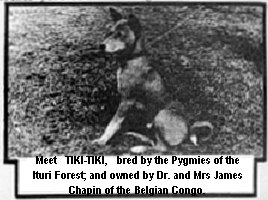
TIKI-TIKI is the word for Pygmy in the trade
language of the northeastern Belgian Congo.
Tiki-tiki the Basenji, owned by Dr. James P.
Chapin of the American Museum of Natural
History during his recent long sojourn in Africa,
was born in the country of the Pygmies - the Ituri
Forest near Mt. Hoyo. On a visit to a camp of
Mambuti (Pygmies) early in 1956, Dr. Chapin
first saw the pup and his three litter-mates lying in
a small leaf-thatched hut typical of Pygmy
improvisation. Tiki cost 70 francs ($1.40), an
exorbitant price in the Congo for a puppy. The
Pygmy-owners originally agreed to 50 fr., but
inasmuch as the Chapins, who were on their way
to Lake Edward, could not take him home
immediately, they were assessed, on their return
call, a service charge of 20 fr.
"When we got him," Dr. Chapin reported,
"he weighed 2.2 lbs. He had evidently been
weaned, for he scorned milk from a nursing
bottle and accepted solid food at once."
"The pup is no prize-winner, but he looks to
me as though he has not one molecule of any
blood other than Basenji. He is a light reddish
brown color. Forehead wrinkles are well devel-
oped; fore-feet and tail-tip are white; toes of
hindfeet white; chest mottled with white. He
would be prettier if he had a white collar, but no-
thing can be done about that and we love him
just the same."
"Tiki's temperament is excellent; he is friendly
with every one he meets, especially the African
cook, Sindano. He has no prejudice about skin-
color, as dogs may that grow among Africans.
He is alert, mischievous and not at all obedient.
Call as we may, he comes only when it suits him."
"He has his own armchair and seldom gets
up in ours any more. Tiki loves to ride around
the country and study the landscape. We can
scarcely open a door of our car without his
jumping in. I have known these Basenjis for 48
years, but never owned one before. Tiki is a
friendly, frisky companion and gives us a lot of
fun."
All of this calls to mind the experiences of
new Basenji-owners everywhere and is
reminiscent of possibly your first Basenji and
certainly mine.
At eight months of age, Tiki stood 18 inches
at the shoulder and measured 18 inches from
front of shoulder to rear of thigh. He weighed 28
lbs., which is not excessive for a Basenji of these
dimensions. He developed into a long-limbed
slender dog with a loosely curled tail and, in these
respects, was similar to many of the early
Basenjis bred in the United States.
The size and the color of the Basenji in Africa
vary from one part of its considerable range to
top of page |
another just as they do in the American coyote,
of which 19 sub-species are recognized in the
United States alone. In the far Southwest,
Canis latrans mearnsi weighs less than 20 lbs.,
in contrast to the north Canadian variety, which
weighs over 60. In Kansas, Canis latrans
latrans, weighing 30 lbs., is grey with rusty or
yellowish overtones, but other sub-species have
taken on the colors of their environments -- from
desert-red to silver, with tints of sagebrush and
buffalo grass in the prairie and plains varieties.
As long ago as the Museum's 1909-1915
Congo expedition, Dr. Chapin noted that there is
a great variation in the coat of the Basenji, from
sandy yellow to rich yellow brown, from light
reddish, brown to deep blackish brown. The last
color, he said, is the least common, but a dark
brown Basenji with a white collar was the kind
that he found most attractive. The handsome tri-
colored Basenji of our show-rings is very rare in
the Belgian Congo and apparently does not occur
in the French Congo.
"It has long seemed to me," he wrote on June
30, 1956, "that the best Basenjis I have seen
were those of the Ituri Forest and the savannas
north of it, right up to the Sudan frontier. The
Azande in Equatoria have dogs of the same blood
as they do in the Uelle District of the Congo.
Only a few weeks ago Armand Denis paid us a
visit and we talked Basenjis. He pointed out that
the physical characteristics change as one travels
southward toward the Kasai, the dogs becoming
rangier, longer-legged, with much less curl in their
tails. It is in the Kasai that the dog bells are hung
from a belt around the loins instead of a collar
on the neck."
And there are still other variations as one
ventures farther south into Rhodesia, northeast
into Nigeria or toward the Atlantic seaboard of
Africa, almost as great as those between the
tawny Mearn's Coyote of Arizona and north-
wester Mexico and it wolf-grey Canadian cousin.
Frequently Basenji-fanciers visiting the Museum
on New York's Central Park West are startled
to find that, in the African Pygmy Group there the
Basenji wearing the great elliptic bell is a slender,
almost totally red specimen, which, though ob-
viously mature is scarcely larger than a Toy
Manchester Terrier. This was a Basenji of type to
found in still another part of Africa's great rain
forest.—Walter Philo, RD #1, Box 169,
Elizabeth Ave., Somerset, N.J. 08873 
|

